
Quick Tips
- Pick an appropriate location.
- Gather and prepare cleaning apparatus.
- Soak your dirty plastic.
- Now it's time to actually clean plastic.
- Rinsing clean plastic.
- Dry your plastic quickly.
Stop. Take a quick look around you and notice how many of your possessions are made from plastic. Crazy, isn’t it? Some of them will be entirely plastic and some will just have a few plastic components. The versatility of the stuff is astonishing. There’s plastic on my monitor, plastic on my three hole punch, plastic on my clock/weather station; hell, I’m even sitting on plastic. If I look out my window, I’m looking at plastic bird feeders. If I look down my shirt….
Anyway. With as common as the stuff is, how is it that the task of cleaning plastic can so often be thoroughly neglected? I would think something that is that prevalent in our lives would garner a little more respect. I think the problem is that people are simply unsure of how to clean plastic. There are, after all, many different grades and types of plastic. Luckily for all of us, plastic is pretty forgiving stuff. The main section of this article will cover a rather general method that I believe to be the best way to clean plastic that is not connected to things like electronics that can be damaged by water. If you had something a little more specific in mind (like the electronics), see if I covered it in the bottom section.
Steps to Cleaning Plastic
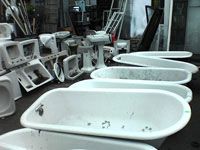 Pick an appropriate location. When it comes time to clean plastic, take the nature and the size of the object you’re cleaning into consideration before you start washing it. If it’s a large piece, like plastic furniture, Big Wheels, storage containers, etc., take ’em outside if weather permits. If not, use the tub. If it’s something small like a kids’ toy, a dish, a figurine, or a…whatever, just use the kitchen or bathroom sink.
Pick an appropriate location. When it comes time to clean plastic, take the nature and the size of the object you’re cleaning into consideration before you start washing it. If it’s a large piece, like plastic furniture, Big Wheels, storage containers, etc., take ’em outside if weather permits. If not, use the tub. If it’s something small like a kids’ toy, a dish, a figurine, or a…whatever, just use the kitchen or bathroom sink.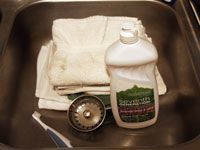 Gather and prepare cleaning apparatus. I’m fond of preparation. When I start a job, I want to have everything I need right at hand so that I don’t have to make a bunch of trips back and forth to grab things I forgot. If you’re washing plastic that’s small, you will need the sink plug, some gentle dish detergent such as Seventh Generation, your hands and some water. If you are working outside, you will need a garden hose, a bucket of warm water, Seventh Generation or equivalent dish soap, and a stack of clean dry towels. For both instances you will want a rag and perhaps an old, soft toothbrush.
Gather and prepare cleaning apparatus. I’m fond of preparation. When I start a job, I want to have everything I need right at hand so that I don’t have to make a bunch of trips back and forth to grab things I forgot. If you’re washing plastic that’s small, you will need the sink plug, some gentle dish detergent such as Seventh Generation, your hands and some water. If you are working outside, you will need a garden hose, a bucket of warm water, Seventh Generation or equivalent dish soap, and a stack of clean dry towels. For both instances you will want a rag and perhaps an old, soft toothbrush.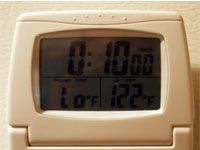 Soak your dirty plastic. If you’re working at the kitchen or bathroom sink, fill it with warm water, stir in a couple tablespoons of detergent, and let the item soak for about 10 minutes before moving to the next step. If you’re working outside with a large item, grab the garden hose and spray down the dirty plastic. After the first spray, give it a few minutes and do it again. After the second hose-down, do it one more time and continue immediately to the next step.
Soak your dirty plastic. If you’re working at the kitchen or bathroom sink, fill it with warm water, stir in a couple tablespoons of detergent, and let the item soak for about 10 minutes before moving to the next step. If you’re working outside with a large item, grab the garden hose and spray down the dirty plastic. After the first spray, give it a few minutes and do it again. After the second hose-down, do it one more time and continue immediately to the next step.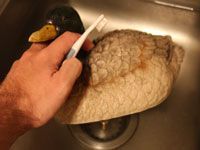 Now it’s time to actually clean plastic. For the smaller items that are in the sink, grab a soft rag, dip it into the sink, and start scrubbing. Seriously, that’s pretty much all there is to it. If you are washing plastic that has a bunch of little nooks and crannies, use an old baby toothbrush to get down inside them. I suggest a baby toothbrush because most plastics scratch pretty easily. For those of you who decided it was best to wash plastic outside, put a few tablespoons of your mild detergent in the bucket of warm water you readied earlier, grab your rag, and get set to clean plastic. Just give it a real good rub down all over and use a baby toothbrush where needed.
Now it’s time to actually clean plastic. For the smaller items that are in the sink, grab a soft rag, dip it into the sink, and start scrubbing. Seriously, that’s pretty much all there is to it. If you are washing plastic that has a bunch of little nooks and crannies, use an old baby toothbrush to get down inside them. I suggest a baby toothbrush because most plastics scratch pretty easily. For those of you who decided it was best to wash plastic outside, put a few tablespoons of your mild detergent in the bucket of warm water you readied earlier, grab your rag, and get set to clean plastic. Just give it a real good rub down all over and use a baby toothbrush where needed.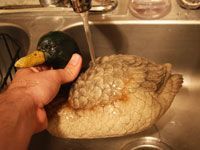 Rinsing clean plastic. Now that you have nice clean plastic furniture, toys, figurines, feeders, etc., it’s time to give them a good rinse. Do this as soon as you can after cleaning to get all of the soap off. Inside, just run your plastic item under the tap. Outside, spray the hell out of it with the hose. Take your time and do a good job. It works best to use a slow stream of water. It will cause less splattering and help keep you from feeling rushed.
Rinsing clean plastic. Now that you have nice clean plastic furniture, toys, figurines, feeders, etc., it’s time to give them a good rinse. Do this as soon as you can after cleaning to get all of the soap off. Inside, just run your plastic item under the tap. Outside, spray the hell out of it with the hose. Take your time and do a good job. It works best to use a slow stream of water. It will cause less splattering and help keep you from feeling rushed.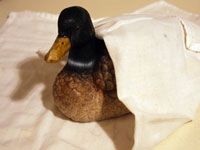 Dry your plastic quickly. This is maybe the most important step in cleaning plastic items. As soon as all the soapy water has been rinsed away, start drying. It’s important to dry plastic quickly as it has a tendency to develop very stubborn water spots that can make your plastic appear dull and dirty. And as with the completion of any chore, reward yourself for washing plastic with a nice cold beer.
Dry your plastic quickly. This is maybe the most important step in cleaning plastic items. As soon as all the soapy water has been rinsed away, start drying. It’s important to dry plastic quickly as it has a tendency to develop very stubborn water spots that can make your plastic appear dull and dirty. And as with the completion of any chore, reward yourself for washing plastic with a nice cold beer.
Further Advice for Cleaning Plastic
- Never use abrasives like steel wool, Brillo Pads, scritchy sponges, Ajax or Comet for cleaning plastic. They will scour and scratch the surface, make your plastic items look like crap, and make future cleanings more difficult.
- When it comes time to clean plastic parts on electronics, the best advice I can give is not to do it. If you’re hell bent on trying it, then do this: make sure the item is unplugged or the batteries are removed, dip a soft sponge in warm soapy water, wring as much of the water out of it as humanly possible, and wipe the plastic down. Next, take a new clean sponge, dip it in warm fresh water, and wipe all of the soap residue off of the electronic piece. Let the piece sit for at least 48 hours before use.
- Cleaning plastic button covers. Use straight white vinegar for cleaning the plastic sheet that covers the push buttons on things like stoves and microwaves. Make sure to dry it off thoroughly when you’re done, or it will streak.
- For cleaning plastic shower curtains, take them outside, lay them out flat, spray them down with a hose, and wipe them down with a 50/50 solution of vinegar and water that you made in a bucket or mixed in a spray bottle. The vinegar will break down the hard water deposit and help kill mildew. Use a lot of the vinegar and water, let it sit on the shower curtain for five minutes, then wipe the entire curtain down with the sponge. Spray it with the hose to rinse it off.
Clean Plastic Naturally
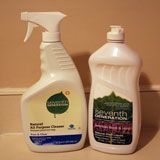 Seventh Generation. Use one of their dish soaps, their All Purpose Cleaner or their Free & Clear Natural Glass & Surface Cleaner. Any one of these will do the trick for you. I’ve been using Seventh Generation products for years now and I’m always impressed with how well they work.
Seventh Generation. Use one of their dish soaps, their All Purpose Cleaner or their Free & Clear Natural Glass & Surface Cleaner. Any one of these will do the trick for you. I’ve been using Seventh Generation products for years now and I’m always impressed with how well they work.
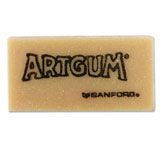 White vinyl or art gum eraser.Use these tools for cleaning the really stubborn grease splatters off of the plastic sheeting that covers the buttons on your stove and microwave. Use the eraser on the grease just like you would on a piece of paper. Have a little patience with this: it will work, but it ain’t gonna happen in the blink of an eye. You can order Art Gum erasers from Amazon.
White vinyl or art gum eraser.Use these tools for cleaning the really stubborn grease splatters off of the plastic sheeting that covers the buttons on your stove and microwave. Use the eraser on the grease just like you would on a piece of paper. Have a little patience with this: it will work, but it ain’t gonna happen in the blink of an eye. You can order Art Gum erasers from Amazon.
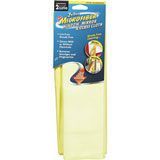 Microfiber cloths. When cleaning plastic, often times all you need is a microfiber cloth, a bit of warm water, and some elbow grease. No chemicals of any sort required.
Microfiber cloths. When cleaning plastic, often times all you need is a microfiber cloth, a bit of warm water, and some elbow grease. No chemicals of any sort required.